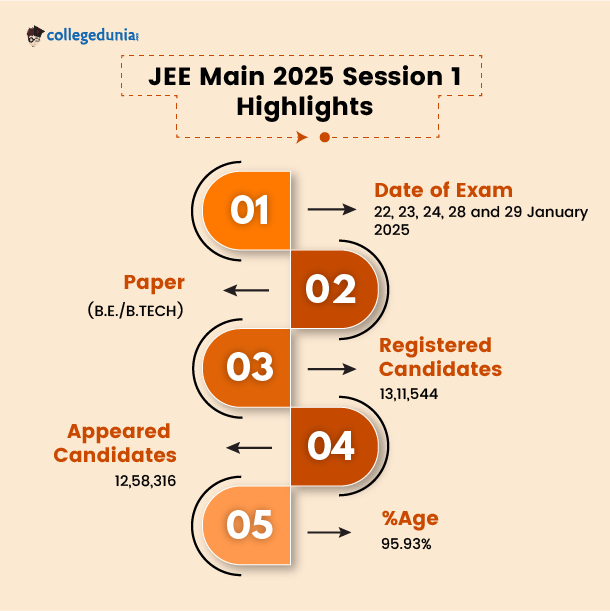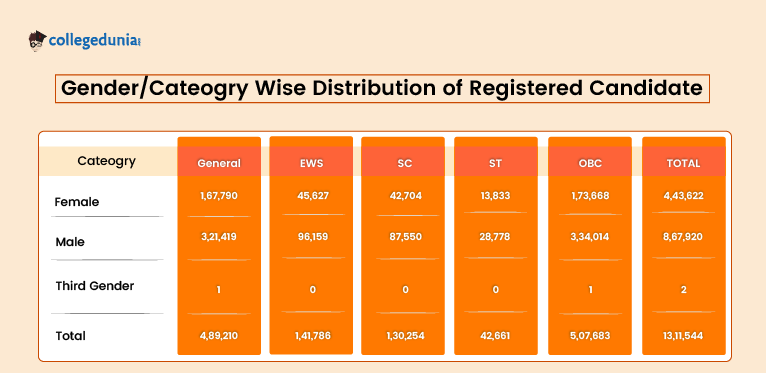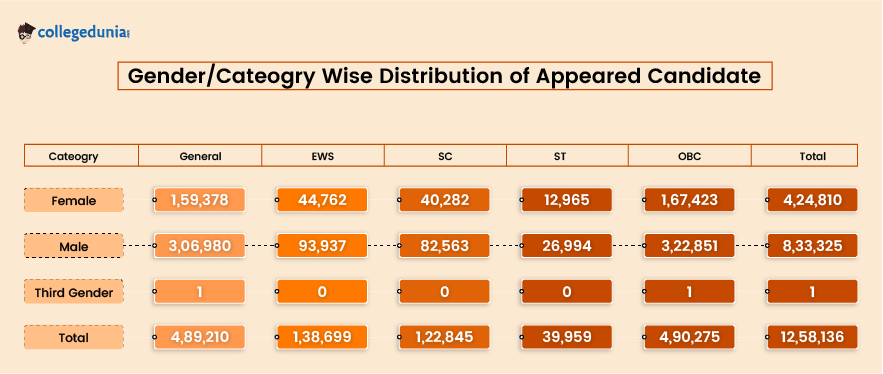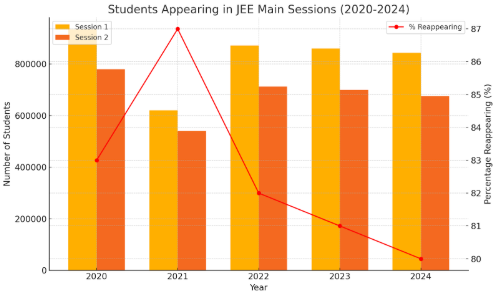JEE Main 2025 Session 1 Result is now available at jee main nta nic results. You can dowload your JEE Main 2025 Scorecard using your JEE Main application number and password.
JEE Main 2025 Paper 1 Session 1 was held in 10 shifts in 618 centres in India and 15 cities outside India on January 22, 23, 24, 28, and 29 for B.E./B.Tech. A total of 13.11 lakh students registered, and 12.58 lakh appeared for the JEE Main 2025 B.E/B.Tech paper, making the attendance rate 95.93%. This included 8.33 lakh male, 4.24 lakh female, and one third-gender candidate. Compared to JEE Main 2024, which had 12.22 lakh registrations and 11.70 lakh candidates appearing (95.8% attendance), the number of students increased this year.
A total of 14 students scored a perfect 100 NTA score in JEE Main 2025 Session 1, including 13 male and one female. Ayush Singhal from Rajasthan is the overall topper whereas Sai Manogna Guthikonda from Andhra Pradesh is the female topper. Rajasthan has the most toppers (5), followed by Delhi and Uttar Pradesh (2 each), while Karnataka, Maharashtra, Gujarat, Andhra Pradesh, and Telangana have one each.
JEE Main 2025 Cut off Percentile for session 1 is expected as-
- General: 94.24
- EWS: 82.33
- OBC: 80.68
- SC: 61.09
- ST: 47.70
JEE Main 2025 Toppers (Released)
The JEE Main 2025 Toppers List has been made public by NTA in a press release featuring candidates who achieved a 100 NTA Score in Session 1 ,along with state-wise, category-wise, and gender-wise toppers.
Check out: JEE Main 2025 Toppers
- JEE Mains 2025 Session 1
- JEE Main 2025 Phase-1 Exam Day Guidelines
- JEE MAIN 2025 Cut-off (Expected)
- JEE Main 2025 Marks vs Percentile
-
- JEE Main 2025 Answer Key Release
- JEE Main 2025 Result
- JEE Main 2025: Syllabus
- JEE Main 2025 Counseling Process
- JEE Main 2025 Phase-1 Difficulty Level
- JEE Main 2025 Exam Pattern
- JEE Main 2025 Session 1: Number of Registered and Expected Candidates to Appear
- Past Year JEE Main Cut-Off Analysis(2024-2022)
- Preparation Tips for JEE Main 2025
JEE Mains 2025 Session 1 Highlights

JEE Main 2025 Question Papers and Solution PDF (Download PDF)
The JEE Main 2025 Question Papers and Solution PDF along with their analysis for JEE Main 2025 22 Jan, JEE Main 2025 23 Jan, JEE Main 2025 24 Jan, JEE Main 2025 28 Jan, JEE Main 2025 29 Jan and JEE Main 2025 30 Jan are now live, along with their memory-based solutions.
| Shift | Question Paper Set | Solution PDF |
|---|---|---|
| JEE Main 2025 22 Jan Shift-1 | Download PDF | Download PDF |
| JEE Main 2025 22 Jan Shift-2 | Download PDF | Download PDF |
| JEE Main 2025 23 Jan Shift-1 | Download PDF | Download PDF |
| JEE Main 2025 23 Jan Shift-2 | Download PDF | Download PDF |
| JEE Main 2025 24 Jan Shift-1 | Download PDF | Download PDF |
| JEE Main 2025 24 Jan Shift-2 | Download PDF | Download PDF |
| JEE Main 2025 28 Jan Shift-1 | Download PDF | Download PDF |
| JEE Main 2025 28 Jan Shift-2 | Download PDF | Download PDF |
| JEE Main 2025 29 Jan Shift-1 | Download PDF | Download PDF |
| JEE Main 2025 29 Jan Shift-2 | Download PDF | Download PDF |
| JEE Main 2025 30 Jan B.Arch | Download PDF | Download PDF |
| JEE Main 2025 30 Jan B.Planning | Download PDF | Download PDF |
JEE MAIN 2025 Cut Off
The cut-off for JEE Main 2025 is the minimum percentile score that the candidate needs to obtain to be eligible for JEE Advanced and further admission into some of the best engineering institutes like NITs, IIITs, and GFTIs. The expected cut-off will be calculated by considering the number of candidates, the difficulty level of the examination, and trends in previous years.
General Category: This is expected to remain steady as compared to the previous year at the 90-95 percentile because of the consistent competition level.
OBC-NCL and EWS Categories: These categories are expected to have a cut-off a little lower than the 70-85 percentile, reflecting the relaxation in eligibility criteria.
SC/ST Categories: The cut-off is likely to fall between the 40-70 percentile, thus providing wider opportunities for candidates from the reserved categories.
| Category | Expected Cut-Off Percentile Range |
|---|---|
| General | 90 - 95 |
| OBC-NCL | 70 - 85 |
| EWS | 70 - 85 |
| SC | 50 - 70 |
| ST | 40 - 60 |
| PwD | 1 - 40 |
Check: JEE Main Cutoff 2025
JEE Main 2025 Marks vs Percentile
The marks vs percentile system for JEE Main 2025 will help the candidate understand how many raw marks have been translated into a percentile score that is used for ranking. The normalization process is involved in calculating the percentile score to avoid inequality among sessions. This plays a significant role in determining rank, which consequently leads to a candidate's eligibility for colleges such as NITs, IIITs, and GFTIs.
Top Percentile (99+): Candidates who score 220+ marks usually score in the top percentile and gain admission to all top NITs and IIITs: NIT Trichy, IIIT Hyderabad, etc.
Mid Percentile (80–90): Marks: 120–180 Admissions are going to mid-range NITs and IIITs.
Lower Percentile (60–80): Candidates falling in this range with a mark of around 80–120 can comfortably join the newer NITs or even state-level engineering colleges.
| Marks Range | Percentile Range | Expected Rank Range | Eligible Colleges |
|---|---|---|---|
| 250+ | 99.9+ | Top 500 | Top NITs (e.g., NIT Trichy, NIT Surathkal) |
| 220 - 249 | 99 - 99.8 | 500 - 5,000 | IIIT Hyderabad, NIT Warangal |
| 180 - 219 | 95 - 98.9 | 5,000 - 15,000 | Mid-tier NITs (e.g., NIT Calicut, NIT Jaipur) |
| 120 - 179 | 80 - 94.9 | 15,000 - 50,000 | Newer NITs, State Engineering Colleges |
| 80 - 119 | 60 - 79.9 | 50,000 - 1,00,000 | State Colleges, GFTIs |
| Below 80 | Below 60 | Above 1,00,000 | Private Engineering Colleges |
Good Score in JEE Main 2025 Phase 1
A good score in JEE Main 2025 Phase 1 depends on various factors, including competition level, the difficulty level of the examination, and what one aspires to achieve. It is defined differently for each section of students- NIT, IIIT, or the qualifying rank for JEE Advanced. In general, a "good score" would be at a percentile such that it helps gain admission into the desired college or institute, along with being pretty competitive.
For Top NITs and IIITs: A score of 250+ is supposed to be excellent, and it may translate to a 99+ percentile.
For Mid-Tier Institutes: Scoring between 180 and 240 is competitive and will get admission in popular branches in good NITs and IIITs.
For Qualifying JEE Advanced: A score of around 90–120 is usually sufficient for General category students to qualify for JEE Advanced, and the cut-off is lower for reserved categories.
Branch Preference: Highly competitive branches like Computer Science require scores upwards of 260+, whereas less competitive branches may be secured with 180–200.
| Score Range | Percentile Range | Admission Opportunities |
|---|---|---|
| 250+ | 99+ | Top NITs, IIITs, and Computer Science branches in Tier-1 institutes. |
| 200–249 | 96–98.9 | Good NITs and IIITs, core branches like Mechanical, Civil, ECE. |
| 150–199 | 90–95.9 | Mid-tier NITs, IIITs, and state-level engineering colleges. |
| 90–149 | 70–89.9 | Qualify for JEE Advanced (General category); regional colleges. |
| Below 90 | Below 70 | Limited options; focus on state or private engineering colleges. |
JEE Main 2025 Rank vs College Predictor
Rank vs college predictor is a good tool for students to estimate how many potential college and course options they can have with their rank. Analyzing past trends and cut-off data, this tool helps the students understand which colleges they can look forward to and how to prepare for counseling by choosing preferences effectively.
| Rank Range | Institutes | Probable Branches |
|---|---|---|
| 1 - 5,000 | Top NITs (e.g., NIT Trichy, NIT Warangal) | CSE, ECE, Mechanical Engineering |
| 5,001 - 15,000 | NITs, IIITs, Top GFTIs | EEE, Civil, Chemical Engineering |
| 15,001 - 30,000 | Lower NITs, IIITs, GFTIs | IT, Metallurgy, Biotechnology |
| 30,001 - 50,000 | State-Level Institutes, Remaining GFTIs | Core Engineering Branches |
| 50,001+ | Private Colleges, State Colleges | Various Engineering & Allied Courses |
Should You Appear for JEE Main 2025 Phase-2 After Phase-1?
Even though JEE Main Phase-1 is crucial, many candidates often appear for Phase-2 to get a better rank in the process, mainly when they feel their Phase-1 performance has not met their expectations or to gain higher scores. Here's a quick guide that'll help you decide if you should appear for Phase 2:
| Factor | Yes, Appear for Phase-2 | No, Don't Appear for Phase-2 |
|---|---|---|
| Phase-1 Performance | If you're not satisfied with your Phase 1 score or rank, appearing for Phase 2 gives you a second chance to improve. | If you scored well in Phase 1 and believe it meets your college or course requirements. |
| Score Expectations | If you need a better score to increase your chances of getting into top institutions. | If your Phase-1 score already meets the criteria for the colleges you’re targeting. |
| Preparation Level | If you're confident about your preparation for Phase 2 and can handle additional revision. | If you're underprepared or feel that Phase 1 was your best attempt. |
| Psychological Readiness | If you're mentally prepared for the exam pressure again and can handle the stress. | If you're mentally exhausted or feel you cannot perform better. |
| Availability of Time | If you have ample time to revise and improve your understanding of weak areas. | If you have no time for additional preparation or if your schedule is too packed. |
JEE Main 2025 Session 1: Number of Registered and Candidates Appeared
The gender and category-wise distribution of candidates for JEE Main 2025 Paper 1 (B.E./B.Tech.) shows that 4,89,210 candidates registered and appeared for the exam. Among them, male candidates significantly outnumbered female candidates across all categories. In the General category, 45,627 females and 96,159 males registered, while 44,762 females and 93,937 males appeared.
The EWS category saw 42,704 female and 87,550 male registrations, with 40,282 females and 82,563 males appearing. For SC, 13,833 females and 28,778 males registered, while 12,965 females and 26,994 males appeared. Additionally, one third-gender candidate registered under General and OBC, but only the OBC candidate appeared.


Past Year Analysis: Students Appearing in Both Sessions of JEE Main(2024-2020)
Analyzing the previous trends in JEE Main is important for determining the pattern of student participation for both sessions. Most students attempt to better their scores in Session 2 as the exam is highly competitive. The graph of participation from the years 2024 to 2020 is important for showing the changes in trends over time.
High Reappearance Rates: Between 2020 and 2024, 80-87 percent of students who appeared in Session 1 decided to reappear in Session 2, a reflection of the importance of the second session in improving performance.
Impact of COVID-19 in 2021: In 2021, the highest reappearance rate stood at 87 percent. This was largely because of the pandemic's influence on preparation and exam performance in Session 1, largely because of the challenges it presented across the board.
Stable Participation Post-2021: In the years since 2021, reappearance trends stabilized to around 80-83% for both sessions, indicating that students continued to depend on both for better scores.
Minor Decline in 2024: The reappearance percentage shows a minor decline in 2024, indicating better preparation strategies for Session 1 or more satisfaction with initial performance.
| Year | Students Appeared in Session 1 | Students Appeared in Session 2 | Percentage of Students Reappearing |
|---|---|---|---|
| 2024 | 8,43,000 | 6,75,000 | 80% |
| 2023 | 8,60,000 | 7,00,000 | 81% |
| 2022 | 8,72,000 | 7,12,000 | 82% |
| 2021 | 6,20,000 | 5,40,000 | 87% |
| 2020 | 9,34,000 | 7,80,000 | 83% |

Past Year JEE Main Cut-Off Analysis(2024-2022)
The cut-off trends of JEE Main over the years have provided insight into how competition, difficulty levels, and the number of candidates affect the qualifying criteria. A study of the cut-offs for 2024, 2023, and 2022 reveals minute variations across categories and percentile ranges, helping the candidates predict the cut-off for 2025 and prepare accordingly.
General Category: For the General category, the percentile cut-off jumped from 88.41 percent in 2022 to 93.23 percent in 2024, indicating increasing competition, with more good students in comparison to previous years.
EWS Category: The percent cut-off percentage for EWS candidates increased suddenly from 63.11 in 2022 to 81.32 in 2024 and reflects improved academic standards and participation among EWS applicants.
OBC-NCL Category: For the candidates belonging to the OBC-NCL category, the cut-off percentile has gone up from 67.00 in 2022 to 79.67 in 2024.
SC Category: The SC category also showed a marked increase in the cut-off percentile. From 43.08 in 2022 to 60.09 in 2024,which shows academic improvement.
ST Category: The cut-off percentile for ST candidates increased from 26.77 in 2022 to 46.69 in 2024. This is a sharp increase that depicts better opportunities and performance in this category.
PwD Category: The cut-off percentile for PwD candidates was extremely low, at 0.0031 in 2022 to 0.0018 in 2024, to ensure that the differently-abled candidates get to participate in the exam.
| Category | 2024 Cut-Off Percentile | 2023 Cut-Off Percentile | 2022 Cut-Off Percentile |
|---|---|---|---|
| General | 93.2 | 90.7 | 88.4 |
| EWS | 81.3 | 75.6 | 63.1 |
| OBC-NCL | 79.6 | 73.6 | 67 |
| SC | 60 | 51.9 | 43 |
| ST | 46.6 | 37.2 | 26.7 |
| PwD | 0.1 | 0.1 | 0.3 |
Score 180-240+ in JEE Main in 7 Days
If you’re aiming to score 180-240+ in just 7 days, it’s essential to follow a structured plan. Focus on high-weightage topics, revise core concepts, and take practice tests. Here’s a detailed 7-day preparation strategy:
| Day | Focus Areas | Preparation Strategy |
|---|---|---|
| Day 1 |
|
|
| Day 2 |
|
|
| Day 3 |
|
|
| Day 4 |
|
|
| Day 5 |
|
|
| Day 6 |
|
|
| Day 7 |
|
|
JEE Main 2025: Syllabus
The JEE Main 2025 syllabus is prepared to test the knowledge of basic concepts in Physics, Chemistry, and Mathematics among the candidates based on the NCERT curriculum for classes 11 and 12. This session's syllabus has been revised with some topics reduced, especially in Physics. Candidates must have a clear understanding of the syllabus to excel in the examination.
JEE Main 2025 Syllabus - Updated
| JEE Main Syllabus PDFs | Links |
|---|---|
| JEE Main 2025 Physics Syllabus pdf | Download pdf |
| JEE Main 2025 Math Syllabus pdf | Download pdf |
| JEE Main 2025 Chemistry Syllabus pdf | Download pdf |
Is the JEE syllabus reduced for 2025?
Yes, though the JEE Main 2025 syllabus has been subjected to minor changes with some subjects being omitted or removed recently to align with the latest revision of the NCERT curriculum for students.
| Subject | Excluded Topics | Percentage of Reduction |
|---|---|---|
| Physics | Magnetism in Matter, Parts of Vector Theory | 5 % |
| Mathematics | Selected subtopics in Three-Dimensional Geometry | 3% |
| Chemistry | Polymers' polymerization methods and Everyday chemicals. | 4% |
Check: JEE Main Syllabus 2025
High-Scoring Topics in JEE Main 2025 Phase-1
JEE Main 2025 is a very competitive exam, and students need to focus on key topics that offer the highest scoring potential. These topics are typically conceptual, heavily weighted in the exam, and have consistently appeared in past papers. By prioritizing these topics, candidates can optimize their preparation and maximize their scores.
Below is a table detailing the high-scoring topics in Physics, Chemistry, and Mathematics for JEE Main 2025:
| Subject | High-Scoring Topics |
|---|---|
| Physics | Mechanics (Laws of Motion, Work-Energy, Rotational Motion) |
| Thermodynamics (Laws, Heat Engines, Entropy) | |
| Electrostatics (Coulomb’s Law, Gauss’s Law, Electric Potential) | |
| Optics (Ray Optics, Wave Optics, Reflection, Refraction) | |
| Modern Physics (Photoelectric Effect, Atomic Models, Nuclear Physics) | |
| Chemistry | Organic Chemistry (Hydrocarbons, Alcohols, Ethers, Carbonyl Compounds) |
| Inorganic Chemistry (Periodic Table, Coordination Compounds, Transition Elements) | |
| Physical Chemistry (Chemical Kinetics, Thermodynamics, Electrochemistry) | |
| Surface Chemistry and Colloids | |
| Mathematics | Calculus (Differentiation, Integration, Applications of Derivatives) |
| Algebra (Quadratic Equations, Progressions, Complex Numbers) | |
| Coordinate Geometry (Straight Lines, Circles, Parabolas) | |
| Probability and Statistics | |
| Vectors and 3D Geometry |
JEE Main 2025 Counseling Process
The Joint Seat Allocation Authority, (JoSAA) manages the online counseling process at IITs, NITs, IIITs, and other Government Funded Technical Institutions (GFTIs). This means that if a candidate meets the qualifying mark of JEE Main 2025, they may participate in online counseling for admission at NITs, IIITs, or GFTIs.
| Counseling Stage | Details |
|---|---|
| Registration | Starts post-JEE Main results. Register at josaa.nic.in to participate. |
| Choice Filling | Fill and prioritize preferred courses and institutes. |
| Mock Seat Allotment | Two mock rounds help refine choices based on initial trends. |
| Seat Allotment Rounds | Multiple rounds allocate seats based on rank and category. |
| Freeze Option | Accept the allotted seat without further participation in the next rounds. |
| Float Option | Retain the current seat while being considered for higher preferences in the next rounds. |
| Slide Option | Retain the current institute but seek an upgrade to a preferred course within the same institute. |
| Seat Acceptance Fee | Fee: General/OBC ₹35,000; SC/ST/PwD ₹15,000, payable online. |
| Document Verification | Submit and verify required documents for admission confirmation. |
| Dual Reporting | Report twice if switching between seat categories like NITs and IITs. |
| Withdrawal Option | Withdraw admission within deadlines to exit the process |
Check: JEE Main Counselling 2025
JEE Main 2025 Phase-1 Difficulty Level
JEE Main exams have maintained a balanced difficulty level across Physics, Chemistry, and Mathematics to test conceptual understanding, problem-solving skills, and time management. Analyzing the difficulty levels of previous years (2024 and 2023) offers valuable insights into trends and preparation strategies.
| Subject | Expected Difficulty Level | Key Focus Areas |
|---|---|---|
| Physics | Moderate | Conceptual clarity, numerical problems in Mechanics, Thermodynamics, and Modern Physics. |
| Chemistry | Easy | NCERT-based Inorganic, straightforward Organic, Physical Chemistry calculations. |
| Mathematics | Tough | Lengthy calculations, advanced-level Algebra, Calculus, and Coordinate Geometry. |
| Overall | Moderate to Difficult | Emphasis on time management and strong conceptual understanding across all subjects. |
Past Year Difficulty Level Analysis(2024 and 2023)
Analyzing the level of difficulty in JEE Main from previous years, such as 2024 and 2023, reveals trends in the subject-wise complexity. This allows the students to align their preparation strategy with the patterns that are likely to prevail in 2025.
| Year | Physics | Chemistry | Mathematics | Overall Difficulty |
|---|---|---|---|---|
| 2024 | Moderate; numerical-heavy, focused on Electricity and Magnetism. | Easy; NCERT-based with predictable Inorganic questions. | Tough; lengthy calculations, focus on Algebra. | Moderate to Difficult. |
| 2023 | Moderate; application-based questions from Modern Physics. | Easy to Moderate; balanced focus on Physical and Organic. | Tough; emphasis on Calculus and 3D Geometry. | Moderate. |
JEE Main 2025 Phase-1 Eligibility Criteria
Candidates need to fulfill the eligibility criteria for appearing in JEE Main 2025 as set by the National Testing Agency (NTA). The eligibility criteria include age, academic qualifications, and the number of attempts allowed. It is essential to ensure that you meet the eligibility criteria so that you are not disqualified from appearing in the exam.
| Eligibility Aspect | Details |
|---|---|
| Age Limit | No upper age limit; candidates must be born on or after October 1, 2000. |
| Educational Qualification | Must have passed or appeared for Class 12 (or equivalent) in 2023/2024 with Physics, Mathematics, and Chemistry/Biology/Biotechnology/Technical Vocational Subjects. |
| Number of Attempts | A maximum of 2 attempts are allowed. |
| Minimum Marks in Class 12 | General category: 75%, SC/ST category: 65%. (or top 20 percentile in respective boards) |
| Nationality | Indian nationals and foreign nationals are eligible. |
JEE Main 2025 Exam Pattern
The exam pattern of the JEE Main 2025 is designed in a way that tests the candidate's analytical ability, problem-solving ability, and concept development. It is divided into two papers: Paper 1 for B.Tech and Paper 2 for B.Arch/B.Planning. While Paper 1 will be computer-based, Paper 2 will contain computer-based sections and some others as pen-and-paper-based sections. The breakdown of the detailed exam pattern follows:
| Aspect | Details |
|---|---|
| Mode of Exam | Computer-Based Test (CBT) for all sections except the Drawing Test (Pen & Paper) |
| Subjects | Physics, Chemistry, Mathematics (Paper 1)Mathematics, Aptitude, and Drawing/Planning (Paper 2) |
| Total Questions | 90 for B.Tech (30 each in Physics, Chemistry, and Mathematics)82 for B.Arch and 105 for B.Planning |
| Question Types | MCQs and Numerical Value-Based Questions |
| Marking Scheme | (+4) for correct answers, (-1) for incorrect MCQs, and no negative marking for numerical questions |
| Duration | 3 hours (180 minutes) |
| Optional Questions | 10 numerical questions per subject, out of which 5 are to be attempted in Paper 1 and Paper 2 |
| Language Options | English, Hindi, and regional languages |
Also,Check: Jee Main 2025 Exam Pattern
Preparation Tips for JEE Main 2025
To score well in JEE Main 2025, candidates need a structured approach, focusing on key concepts, solving practice papers, and effective time management. Some expert tips to prepare are given below:
| Tip | Key Focus | Recommended Hours/Day |
|---|---|---|
| Understand Syllabus & Pattern | Prioritize high-weightage topics for efficiency. | 1-2 hours |
| Time Management | Create and follow a subject-wise schedule. | 5-6 hours |
| Solve Previous Papers | Practice past questions to identify patterns. | 1-2 hours |
| Practice Mock Tests | Simulate exam conditions to boost accuracy. | 2-3 hours (weekly tests) |
| Daily Revision | Reinforce key concepts and improve weak areas. | 1 hour |
JEE Main Previous Year Question Papers
One of the best strategies to get ready for the test is to practice JEE Main past year questions. Candidates can better grasp the exam format, level of difficulty, and commonly asked questions by using these papers.
Below are the Last 5 Year Question paper of JEE Main along with their answer keys:
| Year | Question Paper Link |
|---|---|
| 2024 | JEE Main Question Paper 2024 |
| 2023 | JEE Main Question Paper 2023 |
| 2022 | JEE Main Question Paper 2022 |
| 2021 | JEE Main Question Paper 2021 |
| 2020 | JEE Main Question Paper 2020 |
*The article might have information for the previous academic years, which will be updated soon subject to the notification issued by the University/College.







Comments